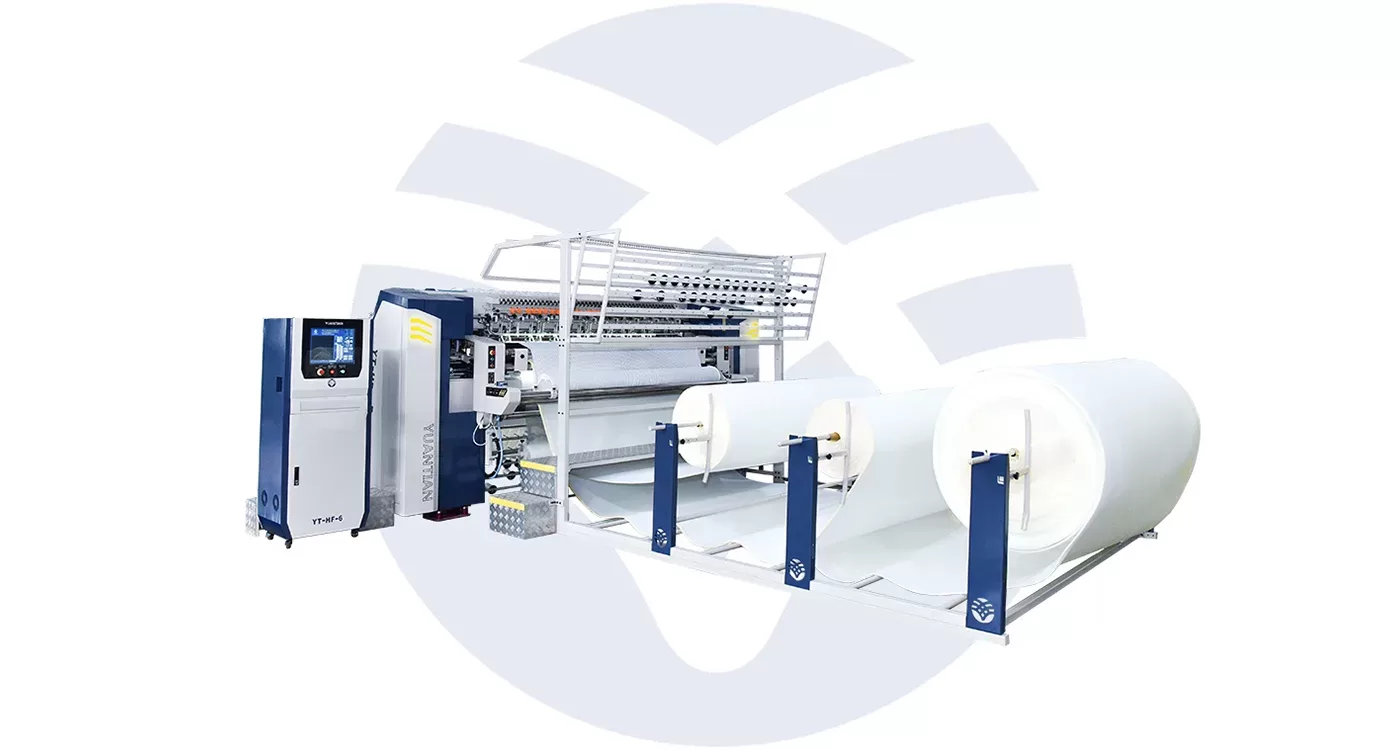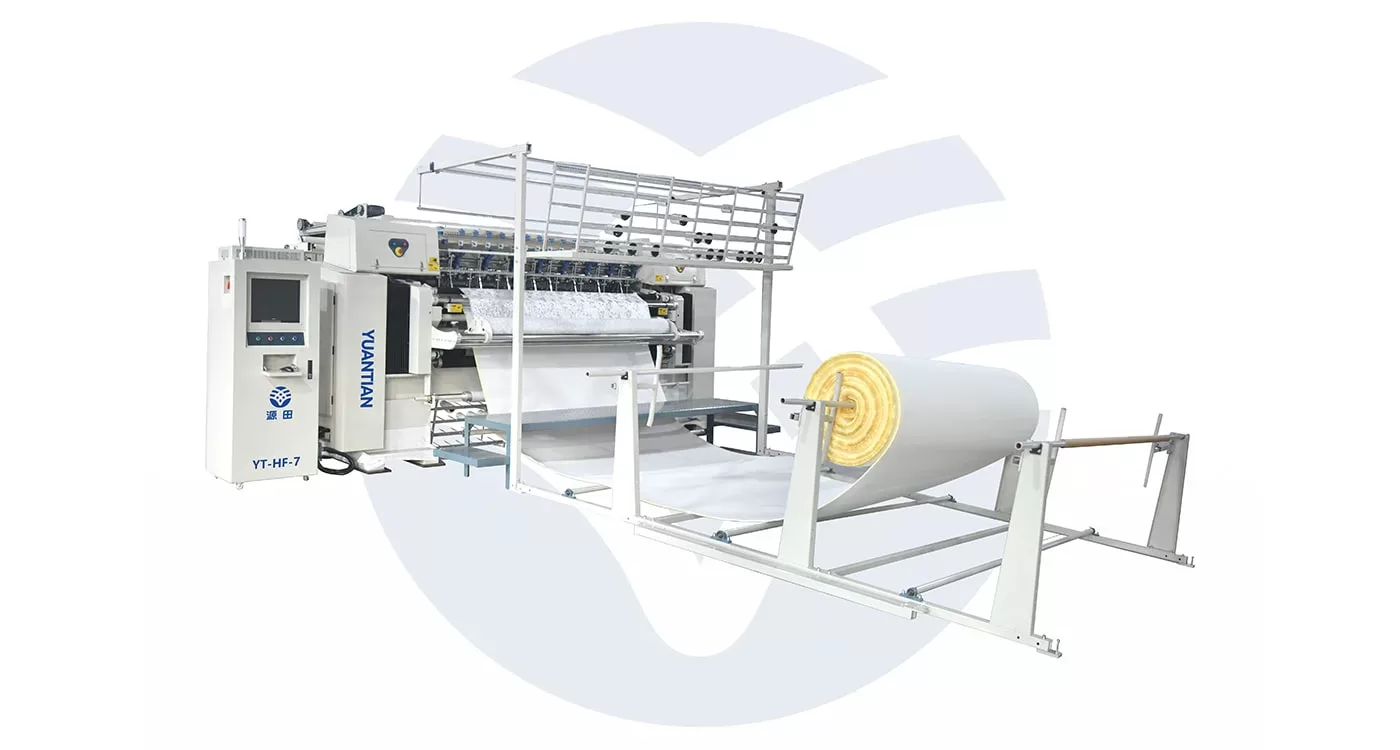- Home » Exploring the Versatility of Mattress Quilting Machines
Mattress quilting machines form the core of making high-quality mattresses, contributing much towards the aesthetic value and structure. The quilting machines would have versatility in handling the diversity of quilting patterns and a wide array of materials.
This passage delves into the different types of mattress quilting machines, their functionalities, and the advantages they bring to the mattress manufacturing process.
Types of Mattress Quilting Machines
Single-Needle Quilting Machines
These machines are specially made to form small and detailed patterns of quilting. They have only one needle that enables them to work on an item with a lot of accuracy and control. Such machines are designed for custom and high-end mattresses where special designs and high-quality workmanship are essential.
Multi-Needle Quilting Machines
Multi-needle quilting machines have a high speed and are manufactured for producing large amounts of quilts. These machines have more than one needle, so they can quilt several lines simultaneously, thereby drastically reducing the time it takes to produce one piece.
This characteristic is applied when large numbers need to be produced. Multi-needle machines play a key role in producing standard mattress designs quickly.
Computerized Quilting Machines
It is the epitome of quilting technology today. The sophisticated software controls these machines, thereby making them able to create complex patterns accurately and consistently. Computerized quilting machines can store many patterns that can be changed quickly and customized to suit market demand.

Key Features and Functions
Pattern Versatility
Another characteristic that truly sets the modern quilting machine apart is its pattern-making capacity. From simple, straightforward lines through florals and geometrics, these machines can turn out quilting that enhances both the aesthetic and practical capabilities of the mattress. This flexibility makes it easier for manufacturers to cater to the preferences of diverse consumers.
Material Compatibility
Quilting machines work on diversified materials such as various fabrics, foams, and fibers. This would provide compatibility for applying the quilting process to diversified mattress constructions, be it a traditional innerspring mattress, memory foam, or a hybrid model.
Automation and Efficiency
Most of the modern quilting machines are highly automated, which allows for reduced operator involvement and increased productivity. Some of the features that are automated in the quilting machine include threading, tension adjustment process, and pattern switching. This leads to increased productivity and consistent quality.
Advantages of Using Quilting Machines
Enhanced Aesthetic Appeal
Quilting adds a layer of sophistication and attractiveness to mattresses. The patterns created by quilting machines can transform a simple mattress into a visually appealing product that stands out in the market. This aesthetic enhancement is crucial for brand differentiation and customer appeal.
Improved Structural Integrity
Quilting enhances not only the looks of a mattress but also its structural integrity. These stitches, done at various layers of the mattress, hold together and keep them from shifting, which allows even wear over time. This added durability again translates to a longevity factor of the product, which means much to consumers.
Customization Capabilities
Quilting machines have a huge potential for customization. Different patterns and materials can be changed by the manufacturer in the shortest possible time to meet any special design or fashion that the customer desires or to follow market trends. This flexibility gives an advantage while dealing in niche markets or special orders by allowing businesses to offer their customers customized products.
Role in Modern Mattress Manufacturing
Meeting Market Demands
In most cases, the mattress industry has proved to be very competitive, with most consumers looking for unique and high-quality products. Quilting machines, therefore, allow manufacturers to come up with a wide range of designs and features. This helps a business be relevant and at par in the dynamic market.
Quality Control
One of the main ingredients of good manufacturing is consistency. Advanced technology quilting machines allow each mattress to be made with stringent quality standards. The automation in these systems allows for very few human errors and therefore is able to give consistent stitching and pattern accuracy across all products.
Efficiency and Cost-Effectiveness
The efficiency of modern quilting machines translates into cost-effectiveness for the manufacturer. With high speed production, lower labor costs, and very little material wasted, it is a much more economical means of manufacturing. This value can be passed on to the consumer in terms of more affordable pricing on high-quality mattresses.
Innovations in Quilting Machine Technology
Smart Quilting Machines
The invention of smart technology has transformed the quilting machine. These machines use sensors and artificial intelligence to fine-tune the quilting process in real-time, enabling perfect performance without wasting much time on downtime or maintenance.
Eco-Friendly Options
Manufacturing today is, therefore, increasingly being guided by sustainability. Among the innovations to quilting machine technology are eco-friendly options that reduce energy and waste. Such machines are designed to be as eco-friendly as possible while maintaining high levels of productivity and quality.
Integration with Other Manufacturing Systems
Modern quilting machines can be integrated with other manufacturing systems for seamless production. This would provide better coordination and efficiency, thus ensuring perfect quilting aligned with other stages of mattress making. The net result would be a smooth workflow that improves overall productivity.
Challenges and Considerations
Initial Investment
Up-front investment will be one of the major challenges that will be encountered while using the advanced machine for quilting. A high-quality, automated quilting machine could be quite expensive. However, their long-term benefits in terms of efficiency and product quality usually pay off against this up-front cost.
Training and Maintenance
Sophisticated quilting machines require good operators. Firms need to invest in training so that the employees are capable of handling the equipment efficiently. It will also mean frequent servicing to keep the equipment running, without which it can result in expensive and painful downtime.
Keeping Up with Technological Advances
With the rapid technological changes in quilting machines, there are constant upgrades needed on the part of manufacturers in order to remain competitive. Keeping up with changes in technology can be challenging but necessary to maintain a leading edge in the marketplace.

Future Trends in Quilting Machine Technology
Increased Automation
Long-term trends in the development of quilting machines are oriented toward increasing their automation. Machines of the future will certainly host even more far-reaching automation capabilities to minimize manual interventions and maximize production efficiency.
Enhanced Customization
As consumer demand rises for higher personalization in products, quilting machines will evolve to give more flexibility when it comes to customization. This could include complex patterns, more diversified materials, and faster pattern-switching speeds.
Sustainability Focus
Sustainability will remain a key focus in the development of new quilting machines. Manufacturers will continue to innovate to create eco-friendly machines that minimize environmental impact without compromising on performance or quality.
Conclusion
Mattress quilting machines are inevitable tools in contemporary mattress manufacturing since they offer flexibility and speed that was before unachievable. They are, therefore, very important for creating quality mattresses, from improving aesthetic and structural values to market requirements and quality consistency.
As technology continues to advance, quilting machines will become even more sophisticated, offering greater customization, automation, and sustainability. Investing in advanced quilting machines is a strategic move for manufacturers looking to stay competitive and meet the evolving needs of consumers.
Связанные с ними товары

















